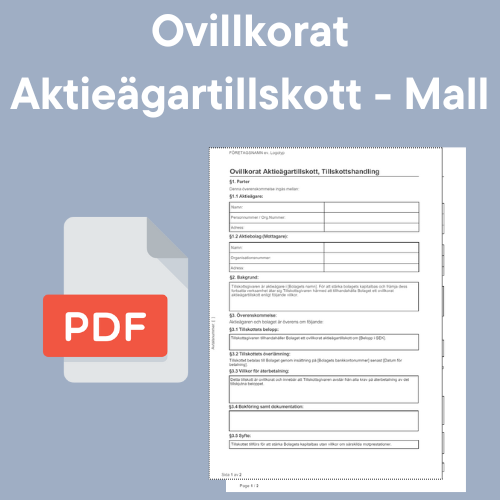Shareholder contribution or Group contribution?
Share
Shareholder contribution or Group contribution?
Table of Contents
Shareholder contribution
Definition and Types
Shareholder contribution means that the shareholders add capital to the company without receiving new shares in exchange. There are two types of shareholder contributions:
- Conditional shareholder contributions : These are paid back to the shareholders when the company's finances allow it.
- Unconditional shareholder contributions : These are not repaid but remain permanently in the company as equity.
Legal and Fiscal Aspects
According to Swedish law, conditional shareholder contributions are not taxable for the recipient, and they may not be added to the acquisition cost of the shares. Repayment of conditional contributions is treated under civil law as a profit distribution and may only take place if the company's creditor protection rules according to the Swedish Companies Act (ABL) are met. This means that the company must have sufficient distributable funds.
When a shareholder contribution is booked, the free equity account is credited, which means a direct strengthening of the company's balance sheet. For unconditional contributions, the amount can be included in the share's acquisition value, which affects taxation in the event of a possible future sale of the shares.
Group contribution
Definition and Purpose
Group contribution means that a company within a group transfers income to another company within the same group to equalize differences in results. This is a common method for optimizing the tax burden within the group.
Legal and Fiscal Aspects
Group contributions are mainly regulated in ch. 35. Income Tax Act (IL). The giver of a group contribution may deduct the contribution, while the recipient must take it up for taxation. This means that the group contribution must be reported openly in both the donor's and the recipient's income tax returns. In order for group contributions to be deductible, certain formal requirements must be met:
- There must have been an actual transfer of value.
- Subsidiaries that give or receive the contribution must have been wholly owned throughout the tax year.
- The contribution must be contained within distributable funds when it is provided from a subsidiary to the parent company.
In civil law, group contributions must be tested against the rules on profit distribution according to ABL. This means that the grant must not exceed what could be distributed as profit.
Practice and Examples
Shareholder contribution
The Supreme Administrative Court has in several cases dealt with questions regarding shareholder contributions. For example, in RÅ 2002 ref. 107, it was established that the value of a contribution cannot exceed the value of the assets at the time the contribution is left. This affects how the conversion of receivables into shareholder contributions is assessed for tax purposes.
Group contribution
An important legal case regarding group contributions is RÅ 1985 1:10, where it was determined that the sale of shares and the right to repayment of a conditional shareholder contribution must be treated separately for taxation.
Summary
Both shareholder contributions and group contributions offer important tools for capital contributions and tax optimization within companies. Shareholder contributions strengthen the company's equity directly and can be conditional or unconditional, while group contributions are mainly used for profit equalization within groups and are subject to both civil and tax regulation. It is important to follow the specific rules and requirements that apply to each method to avoid tax and legal problems.
Accounting
The accounting of various capital contributions such as shareholder contributions and group contributions differs depending on their nature and conditions. Here is an overview of how these transactions can be posted:
Unconditional Shareholder contribution
An unconditional shareholder contribution is recorded as a contribution to unrestricted equity.
- Debit : 1930 - Bank account (amount of the contribution)
- Credit : 2093 - Shareholder contributions received (amount of the contribution)
Conditional Shareholder contribution
A conditional shareholder contribution is recorded as a liability that the company is obliged to repay when the conditions are met.
- Debit : 1930 - Bank account (amount of the contribution)
- Credit : 2393 - Conditional shareholder contributions (amount of the contribution)
Group contribution received
The receipt of a group contribution is recorded as income.
- Debit : 1610 - Group receivables (amount of contribution)
- Credit : 3930 - Group contributions received (amount of the contribution)
Group contribution left
The provision of a group contribution is booked as an expense.
- Debit : 6990 - Other external costs (the amount of the grant)
- Credit : 1610 - Group receivables (bel opened by the grant)
New issue of Shares
New issue means that new shares are issued, and the capital added increases the company's share capital and premium fund.
- Debit : 1930 - Bank account (subscription amount)
- Credit : 2081 - Share capital (nominal amount)
- Credit : 2097 - Premium fund (amount in addition to the share capital)
Convertible Loans
Convertible loans are initially recorded as a liability. When converted to shares, the amount is reclassified to equity.
- Debit : 1930 - Bank account (amount of the loan)
- Credit : 2390 - Loan debts (amount of the loan)
When converting:
- Debit : 2390 - Loan debts (amount of the loan)
- Credit : 2081 - Share capital (nominal amount)
- Credit : 2097 - Premium fund (amount in addition to the share capital)
Preferred shares
Preference shares are booked in the same way as a new issue, where the capital is added to the share capital and the share premium fund.
- Debit : 1930 - Bank account (issue amount)
- Credit : 2082 - Preference shares (nominal amount)
- Credit : 2097 - Premium fund (amount in addition to the share capital)
By understanding and correctly applying the accounting principles for these different forms of capital injection, companies can ensure that their financial statements are accurate and that they meet all relevant legal and tax requirements.



